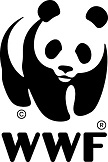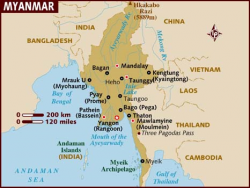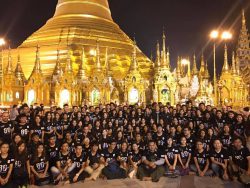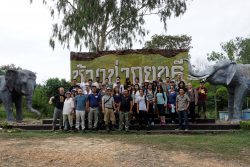
 One of the reasons that made me choose the full-time Master at ESMT is the international exposure options that the program offers. As part of the curriculum, I had the chance to go to Seoul and Tokyo for the International Field Seminar and to IE Business School in Madrid for the one-week exchange within the Global Network for Advanced Management. And upon graduation, combining my passion for travelling with my desire of making a positive impact, I enrolled in the ESMT Responsible Leaders Fellowship and joined the panda family at WWF in Myanmar.
One of the reasons that made me choose the full-time Master at ESMT is the international exposure options that the program offers. As part of the curriculum, I had the chance to go to Seoul and Tokyo for the International Field Seminar and to IE Business School in Madrid for the one-week exchange within the Global Network for Advanced Management. And upon graduation, combining my passion for travelling with my desire of making a positive impact, I enrolled in the ESMT Responsible Leaders Fellowship and joined the panda family at WWF in Myanmar.
 Myanmar (formerly known as Burma) is a country in South East Asia bordered by Bangladesh, India, China, Laos and Thailand. After its independence from the British empire in 1948, Myanmar was flourishing and one of the richest nations in South East Asia. However, five decades of military dictatorship following the coup d’tat in 1962 isolated the country and left it in poor shape.
Myanmar (formerly known as Burma) is a country in South East Asia bordered by Bangladesh, India, China, Laos and Thailand. After its independence from the British empire in 1948, Myanmar was flourishing and one of the richest nations in South East Asia. However, five decades of military dictatorship following the coup d’tat in 1962 isolated the country and left it in poor shape.
Recently, the country has undertaken democratic reforms, opening its borders and liberalizing its economy, in the hope of becoming again a prosperous nation integrated into the global community. Realizing the potential but also foreseeing numerous challenges, WWF (World Wide Fund for Nature) opened an office there in 2014 to promote sustainability and conservation principles while supporting the development of a greener economy.
 Before landing in Yangon, I had few expectations about my life for the next six months. Leaving my Canadian winter behind for tropical weather, I knew that power outages were common during the warm season, that telecom services were also unstable, and that hygiene would be nowhere near my western standards. Somewhat prepared for the worst, I was charmed immediately by the city and my new tidy apartment provided by WWF.
Before landing in Yangon, I had few expectations about my life for the next six months. Leaving my Canadian winter behind for tropical weather, I knew that power outages were common during the warm season, that telecom services were also unstable, and that hygiene would be nowhere near my western standards. Somewhat prepared for the worst, I was charmed immediately by the city and my new tidy apartment provided by WWF.
 The office did not disappoint either. In a large and beautiful house, I sit with the sustainable business team while working on my assignment that focuses on formulating a strategy to help WWF achieve its conservation objectives by influencing the financial flows in Myanmar.
The office did not disappoint either. In a large and beautiful house, I sit with the sustainable business team while working on my assignment that focuses on formulating a strategy to help WWF achieve its conservation objectives by influencing the financial flows in Myanmar.
In a nutshell, I am building a roadmap for local banks to integrate environmental and social matters into their activities and I am conceiving innovative financing mechanisms to catalyze green investments and restrain brown investments. It is both a very interesting and challenging task to find ways to connect with other stakeholders, explain how our proposal is also beneficial to them, and convince them to take actions.
 Beyond this project, I also participated in the organization of Earth Hour 2017 hosted at the Swe Dagon Pagoda in Yangon on March 25th. With the help of the public and dozens of young volunteers, we lit 10,000 oil lamps to pledge against climate change. The event was an important branding exercise for WWF to showcase its work and receive national media coverage.
Beyond this project, I also participated in the organization of Earth Hour 2017 hosted at the Swe Dagon Pagoda in Yangon on March 25th. With the help of the public and dozens of young volunteers, we lit 10,000 oil lamps to pledge against climate change. The event was an important branding exercise for WWF to showcase its work and receive national media coverage.
 One week later, I attended the staff retreat in Kui Buri and Kaeng Krachan national parks in Thailand. For a week, the whole office got together to reinforce friendship and work on teaming and team-building exercises. It was also a great opportunity to connect with nature and observe elephants as well as other forms of wildlife in action.
One week later, I attended the staff retreat in Kui Buri and Kaeng Krachan national parks in Thailand. For a week, the whole office got together to reinforce friendship and work on teaming and team-building exercises. It was also a great opportunity to connect with nature and observe elephants as well as other forms of wildlife in action.
 During my time off, I like to explore and learn about the culture of the country. I discovered Bagan and its thousands of pagodas and I experienced the floating villages and gardens on Inle Lake. I read about Myanmar’s history from General Aung San, the Father of the nation, to his daughter Aung San Suu Kyi, Nobel Peace Prize winner and incumbent State Counselor.
During my time off, I like to explore and learn about the culture of the country. I discovered Bagan and its thousands of pagodas and I experienced the floating villages and gardens on Inle Lake. I read about Myanmar’s history from General Aung San, the Father of the nation, to his daughter Aung San Suu Kyi, Nobel Peace Prize winner and incumbent State Counselor.
 Meanwhile, I have met amazing people and made new friends who are making my experience truly memorable. Together there is always something awesome to do, whether it is for a sunset boat party, a happy hour on a rooftop terrace or a jazz event at the French Institute. From the whole experience, those guys are what I am going to miss the most. They made me a very happy panda!
Meanwhile, I have met amazing people and made new friends who are making my experience truly memorable. Together there is always something awesome to do, whether it is for a sunset boat party, a happy hour on a rooftop terrace or a jazz event at the French Institute. From the whole experience, those guys are what I am going to miss the most. They made me a very happy panda!
 I will soon return to Berlin and the business world, but I am bringing back wonderful memories for the rest of my life. For that, I would like to thank ESMT and Gaurav Gupta, my supervisor and 2014 ESMT alumnus, for making it possible.
I will soon return to Berlin and the business world, but I am bringing back wonderful memories for the rest of my life. For that, I would like to thank ESMT and Gaurav Gupta, my supervisor and 2014 ESMT alumnus, for making it possible.
